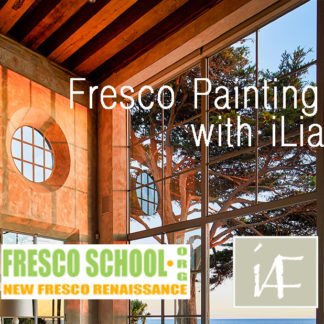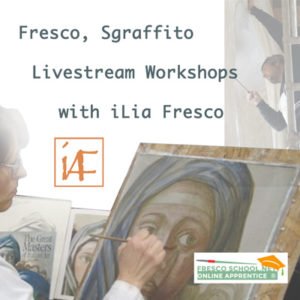“Fresco Painting is only as good as the plaster it is put on. It is impossible to paint a buon fresco without clear understanding of plaster and it’s properties. Improper plaster will reject paint – there are NO shortcuts in fresco!”
iLia Fresco (Anossov) about fresco plaster coats.
Fresco Plaster Coats are made of high calcium lime putty and “aggregate”. Most commonly used aggregate is washed river sand, marble meal, volcanic tuff or the combination of it. The proportion of the mortar or plaster mix generally is:
1 part lime putty : 2 parts aggregate (sand)
or
5 parts lime putty : 8 parts aggregate (sand)
Washed River Sand is the best aggregate for making a fresco plaster, it is clean from impurities such as silica, dust, clay, organic particles, and the biggest enemy of all plasters – SALTs. This sand is also most likely to be of a right angular shape needed for “proper interlocking”.
FrescoShop.com offers Washed River Sand, sifted and ready for intonaco or arriccio plaster.
Classic Fresco Plaster Coats
Traditionally, or the wall/ceiling fresco there are five distinctive fresco plaster coats (from last to first):
1. Intonaco or Top/Skim Coat – final plaster coat on which the actual painting is done. Traditional proportion is 5×8 of lime putty to aggregate (sand). Optionally a topping painting “skin” of 1/16″ with plaster mixed at 1×1 proportion of lime and marble dust is used. This “top skin” layer is applied wet-into-wet over base Intonaco coat of fresco plaster.
This method implies advanced understanding or fresco techniques. This “skim coat” seals, equalizes and densifies the plaster body, but makes it less absorbent and less forgiving. Most of the great renaissance frescoes did not utilize that. This method was used by Diego Rivera. However, it was the most popular during the Early Roman times in Pompeii. This topcoat is also known as “Marmorino” or “Roman Marmorino“.
2. Arriccio or Brown Coat – smooth, sand finish coat on which intonaco is applied.
3. Float Coat – smooth plaster coat, base for arriccio coat (It is fine to apply arriccio coat over floated Rough Coat if the wall is already flat). This coat is fine leveled and floated with darby and large wooden float. Usually this would be a “conventional” stucco finish installed by plastering contractor (referred to as “scratch & brown” in 3-coat stucco system).
4. Rough Coat – rough plaster coat made with somewhat coarse sand. This coat is often combined with float coat by conventional plastering contractors (referred to as “scratch & brown” in 3-coat stucco system).
5. Scratch Coat – the initial and one of the most important coats. This coat is applied directly to wire mash or wooden lath and then scratched with “tooth edged” trowel. Cement is often added to this coat for hard and fast setting.
Fresco Sgraffito Plaster Coats
Historically sgraffito is often combined with fresco painting and/or mosaic on the same wall (or panel) withing the same application.
Essentially, Sgraffito Plaster Coats are identical to Fresco Plaster Coats. The difference is that the “Arriccio” plaster coat is colored by addition of the pigment. Optionally, arriccio plaster, that is used for sgraffito application, can, be fortified with either pozzolana and/or cocciopesto (brick dust). In contemporary practice Portland cement and/or polymers are widely used instead.
FrescoShop.com offers a line of Sgraffito Grip and Base fortified universal dry mixes developed by the Fresco School. Use “Sgraffito Grip and Base” over existing plaster or non-porous surfaces, like painted (primed) drywall or panels; for extra strength on non-porous surfaces see Isolating Primer method. For the final sgraffito coats we have our Arriccio Plaster and Roman Marmorino for the Top/Skim Coat. More about – Sgraffito Plaster Coats and Application.
Fresco Mortar
Mortar for fresco plaster coats is mixed differently then for conventional plastering. In preparation of the mortar for fresco painting only high calcium lime putties and traditional mixing methods are used.
Conventional plastering has moved from calcium based lime putties to magnesium based hydrated limes in powder form. That altered the technique of mixing mortar. Traditionally, aggregate (sand) is added to lime putty and mixed together until the resulting mortar gains plasticity and no “dry” sand lumps are present.
Currently modern day outdoor stucco or interior plaster is made with magnesium enhanced hydrated dry lime. It is mixed with sand and water is added in much larger amounts than it is suitable for fresco plaster. Excess of water makes mixing easier. Also, due to high magnesium content, resulting mortar sets much faster. That is very convenient for modern construction but absolutely futile for fresco painting.
FrescoShop.com offers a variety of Premixed Fresco Plasters, Aged Lime Putty and Aggregates (marble meal, brick dust, coal slug, cocciopesto, etc.)
“Buon Fresco Foundations” – Fresco Plaster DVD video introduces the student to the foundational principles and techniques of the preparation and application of slaked lime plaster for fresco painting. Topics illustrated include the step-by-step process of plaster preparation which is filmed in real time without omissions. A student will be able to see exactly how long each step takes and what tools and methods each requires. iLia Anossov (fresco) guides the student by a thorough and clear demonstration of the foundations of calcium fresco plastering relevant to any size fresco.
Specialty Fresco Plaster Coats
Grip Coat – a special adhesive plaster coat used to prime latex or other “film creating” paint painted surfaces prior to application of the Arricccio and Intonaco coats. The example of such surface can be a wooden panel, drywall, plywood and any other non-porous surface. Plaster Grip Coat can also be used where sandblasting of previously painted stucco or masonry is not advised. (Very old paint may contain led).
In such instances traditional Scratch and Rough Coats are not needed, since the wall or panel is already flat and smooth. We offer premixed, extra strength dry “Fresco plasterGrip” Regular (#18 mesh) and for ceilings and large walls and “Fresco plasterGrip” Fine (#30 mesh) – for smaller, movable fresco panels.
Alternatively, to reduce the thickness and weight of a fresco you can combine Arriccio and Grip coats into a single coat using Fresco PlasterWeld. Plaster Weld provides regular strength adhesion which is sufficient for smaller movable panels, but not recommended for ceilings.
Fresco School has developed marble and/or quartz textured Isolating Primer method. Use Fine Texture for small fresco sgraffito panels and boards, secco fresco, decorative fresco, venetian plaster, lime plaster and marmorino applications and combination of Rough & Fine Textures for larger panels, bards and walls.
Isolating Primer method is also an excellent sealing primer undercoat for limewash and milk paints. Use over non-porous or previously painted with latex paints substrates (drywall, latex painted stucco, wood, tile, etc.)
Historic Plaster Mixes (Compositions):
Opus signinum (‘cocciopesto’ in modern Italian) is a building material used in ancient Rome. It is made of tiles broken up into very small pieces, mixed with mortar, and then beaten down with a rammer. Pliny the Elder in his Natural History describes its manufacture: “Even broken pottery has been utilized; it being found that, beaten to powder, and tempered with lime, it becomes more solid and durable than other substances of a similar nature; forming the cement known as the “Signine” composition, so extensively employed for even making the pavements of houses.” (Wikipedia)
Cocciopesto was widely used in Pompeii for wall construction of the base coats – Scratch, Rough, Float/Arriccio (progressively reducing the sifting mesh size). General proportion is 1/4 to 1/3 of the aggregate – for example: 1 part lime 2 parts aggregate, becomes 1 part lime 1/2 cocciopesto (crushed brick) 3/2 ( 1 & 1/2) of sand.
Pozzolana (plaster with pozzolan) – Vitruvius, writing around 25 BC in his Ten Books on Architecture, distinguished types of aggregate appropriate for the preparation of lime mortars. For structural mortars, he recommended pozzolana. Vitruvius specifies a ratio of 1 part lime to 3 parts pozzolana for cement used in buildings and a 1:2 ratio of lime to pozzolana for underwater work.
The use of only pozzolana in the mix (without sand) is partially due to the economics and simplicity – pozzolana was easily available and cheap. Generally, in 1:3 (lime:pozzolana) mix only 1 part of pozzolana is chemically binds to lime and other 2 parts act as an inert aggregate, hence can be replaced with any other aggregate aka river sand, marble sand without weakening the mix.
Pozzolana as well as cocciopesto are completely optional, majority of Classic Frescoes in Europe and around the world are done with regular lime/sand mortars.
Classic proportions using pozzolana and/or* cocciopesto:
Scratch coat – 1 slaked lime putty, 1 sand, 1 pozzolana, 2 cocciopesto (crashed clay brick or ceramics) or 1 slaked lime putty, 2 sand, 1-2 pozzolana and/or* cocciopesto
Rough and Brown Coats – 1 lime, 2 sand, 1 pozzolana and/or* cocciopesto
Optional (mainly for exteriors or for sgraffito work)
Float/Arriccio Coat – 1 lime, 2 sand, 10-15% (1/3-1/2) pozzolana and/or* cocciopesto
*(and/or means either or both but totaling 1 part)







